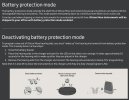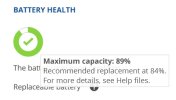pvc
Well-Known Member
- Joined
- Apr 12, 2023
- Messages
- 1,939
- Reaction score
- 585
This is partially reproduced here from aDIY School Hearing Aids PDF file named (Rechargeable Li-ion Battery Maintenance) because not everyone likes to receive information from cloud storage PDF files. Also, this forum-topic-version is open to comments, questions, and discussion. Though, for the long term it is best to read the DIY School complete version which is also maintained and kept up-to-date.
In general, Lithium ion batteries (Li-ion) should not be stored for long periods of time, either uncharged or fully charged. Thus, new rechargeable hearing aids (when unboxed) are only partially charged, and also turned off. Placing new rechargeable hearing aids in their charger will turn them on to get the hearing aids ready for use, but they will not be fully charged. Therefore, you (or your audiologist) may want to leave new hearing aids in the charger until the hearing aid leds turn green indicating they are fully charged.
Using your hearing aid Phone App to read the battery charge levels and then adjust the battery charge levels to approximately (50% or 60%) by partially charging or partially discharging the batteries. Then turn them off until:
Rechargeable Li-ion Battery Maintenance:
Simply charge your hearing aids in the charger at night, and then wear your hearing aids the next morning. That’s all there is to it! Right? Well, Yes. However, there are other considerations.In general, Lithium ion batteries (Li-ion) should not be stored for long periods of time, either uncharged or fully charged. Thus, new rechargeable hearing aids (when unboxed) are only partially charged, and also turned off. Placing new rechargeable hearing aids in their charger will turn them on to get the hearing aids ready for use, but they will not be fully charged. Therefore, you (or your audiologist) may want to leave new hearing aids in the charger until the hearing aid leds turn green indicating they are fully charged.
Checking Battery Charge Levels:
You can use your hearing aid Phone App to read the battery charge levels. You can also use the hearing aid fitting software to read your battery charge Levels. Though, using the fitting software requires a basic understanding of adding a client to your database and connecting to that client’s hearing aids.Storing Rechargeable Hearing Aids:
At some point you may have a need to store your rechargeable hearing aids as a backup pair. It bears repeating that, in general, Lithium ion batteries (Li-ion) should not be stored for long periods of time, either uncharged or fully charged. So don’t do it;- Don’t fully deplete the batteries and then put them in storage
- Don’t fully charge the batteries and then put them in storage
Using your hearing aid Phone App to read the battery charge levels and then adjust the battery charge levels to approximately (50% or 60%) by partially charging or partially discharging the batteries. Then turn them off until:
- you are ready to be start using them again, or
- once every 3 months, recharge to 100% before storing again at (50% or 60%) charge
Last edited:



